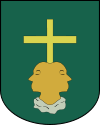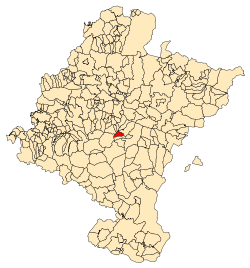Barásoain
Barásoain is a town and municipality in the autonomous community of Navarre, northern Spain, within the historical lands of the Basque Country (greater region). As of 2019 the population stands at 621. It is located approximately 25 km south of Pamplona, the provincial capital.
.
Barásoain | |
|---|---|
 Flag  Seal | |
 | |
 Barásoain Location in Spain | |
| Coordinates: 42°36′13″N 1°38′47″W | |
| Country | |
| Autonomous community | |
| Province | Navarre |
| Comarca | Tafalla |
| Judicial district | Tafalla |
| Government | |
| • Mayor | Rita Delia Roldán Murillo |
| Area | |
| • Total | 13.94 km2 (5.38 sq mi) |
| Elevation | 523 m (1,716 ft) |
| Highest elevation | 644 m (2,113 ft) |
| Lowest elevation | 492 m (1,614 ft) |
| Population (2018)[1] | |
| • Total | 639 |
| • Density | 46/km2 (120/sq mi) |
| Demonym(s) | Barasoaindarra |
| Time zone | UTC+1 (CET) |
| • Summer (DST) | UTC+2 (CEST) |
| Postal code | 31395 |
| Website | Official website |
Famous citizens
- Martín de Azpilcueta (1492–1586). Spanish canonist and theologian in his time, and an early economist, known as Doctor Navarrus
- José Julián de Aranguren (1801–1861). Archbishop of Manila (Filipinas)
- Manuel Turrillas (1905–1997), "Maestro Turrillas", one of the most popular composers of Navarra; composed the most popular hymns of the main San Fermines Associations', Aldapa, Anaitasuna, La Jarana, Muthiko, Oberena, and the Osasuna football club hymn.
- Imanol Bengoetxea Goikoetxea (Andoain, Gipuzkoa, 1962 – Barasoain, 1994), Imanol moved to Barasoain at age 13, became a self- taught artist producing artworks including drawings, oil paintings, water colours, portraits, self-portraits, still lifes and sculptures.
Geography
Barasoain is located 25 km south of Pamplona and 15 km north of Tafalla, on a promontory of 523 m above sea level. The point of lowest altitude of the village is situated at 492 meters, on the river Zidacos bank, and the highest is Mount Artebeltz, at 644 metres. It is the largest village in the Orba valley, known as the Valdorba which was made famous by the legendary singer songwriter Benito Lertxundi
Neighbouring municipalities
The municipality of Barásoain is closely linked to its neighbouring township, Garínoain. Despite their administrative borders, separated by a street, both municipalities form a single urban conglomeration. Other surrounding municipalities are (clockwise starting from west) are Artajona, Añorbe, Tirapu, Olcoz, Unzué and Olóriz.
Climate
Barásoain is located in a transitional climatic region. It borders the Oceanic and the Mediterranean climates, showing a pattern influenced by both. It is, nevertheless, classified as having an oceanic climate (Köppen Cfb).[2]
Template:Weather station
Government
Barásoain belongs to the Judicial district of Tafalla, within the merindad de Olite, one of the five merindades, the Medieval administrative subdivision that has historically divided the region of Navarre.
| Term of office | Mayor | Political party |
|---|---|---|
| 1995–1999 | Juan José Liberal Fernández | independent |
| 1999–2003 | Carlos Enrique Izuriaga Eslava | independent |
| 2003–2007 | Carlos Enrique Izuriaga Eslava | independent |
| 2007–2011 | Carlos Enrique Izuriaga Eslava | independent |
| 2011- | Rita Delia Roldán Murillo | independent |
Demography
Although the population of Barásoain has been either static or slowly declining for the 20th century, there has been an upturn in the figures in recent years due to the new residential development. The village has physically expanded and new people from other places have come to Barasoain, mostly from Pamplona.
| 1897 | 1900 | 1910 | 1920 | 1930 | 1940 | 1950 | 1960 | 1970 | 1981 | 1991 | 2001 | 2006 | 2010 | 2019 |
|---|---|---|---|---|---|---|---|---|---|---|---|---|---|---|
| 617 | 638 | 650 | 636 | 651 | 679 | 594 | 572 | 551 | 462 | 421 | 509 | 636 | 656 | 621 |
References
- Municipal Register of Spain 2018. National Statistics Institute.
- "Clasificación climática de Köppen en Navarra" (PDF). Gobierno de Navarra. Retrieved 2010-05-13.
External links
| Wikimedia Commons has media related to Barásoain. |
- barasoain.net - official website (in Spanish)
- Barásoain in the Bernardo Estornés Lasa - Auñamendi Encyclopedia (Euskomedia Fundazioa) (in Spanish)